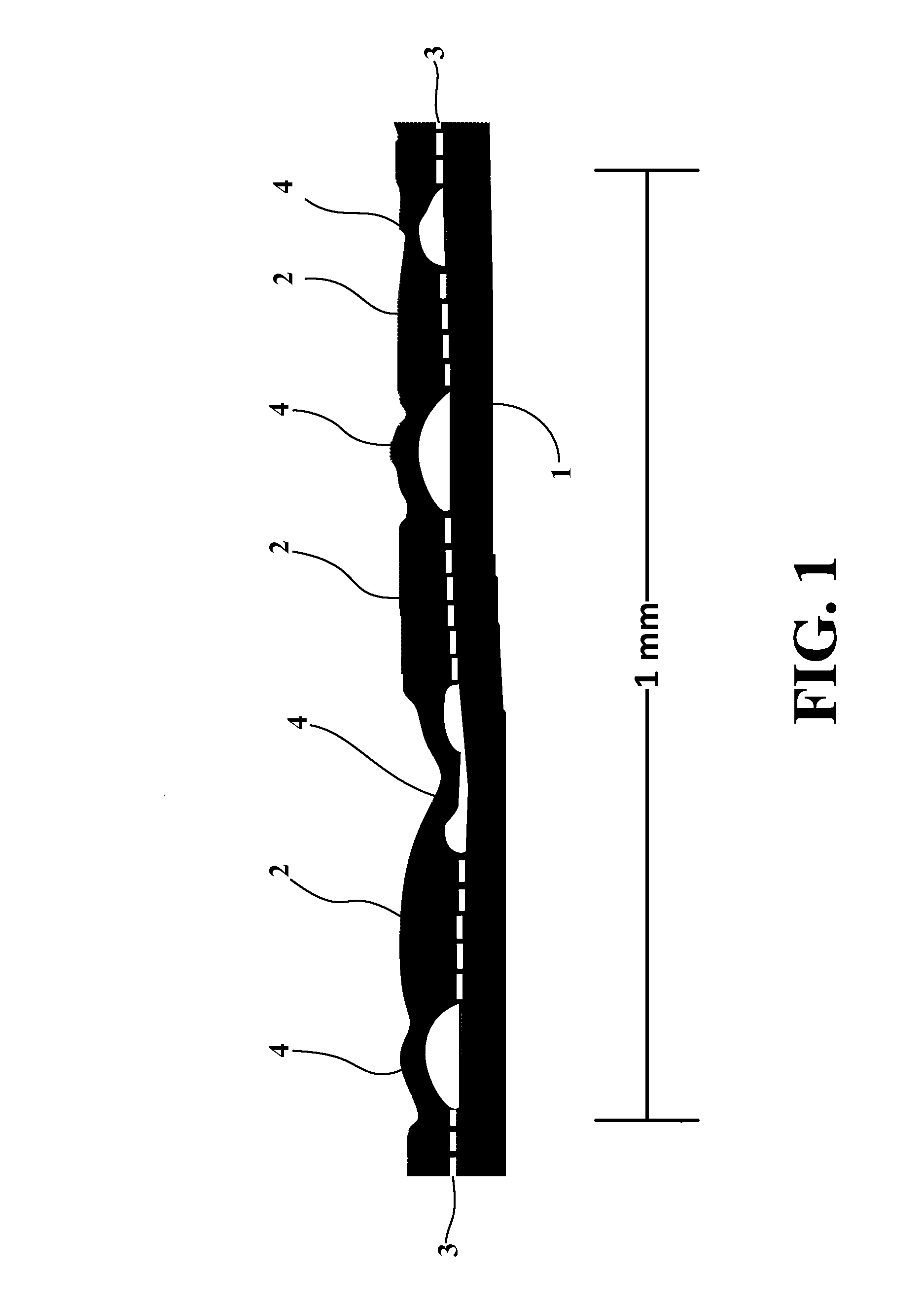Crosslaminate of oriented films and methods and apparatus for manufacturing same
a technology of oriented films and crosslamination, which is applied in the field of crosslamination, can solve the problems of poor tear propagation resistance of thin crosslaminations, and inability to meet the requirements of users, and achieve the effect of improving the pattern of bosses and webs, and improving the tear propagation resistan
- Summary
- Abstract
- Description
- Claims
- Application Information
AI Technical Summary
Benefits of technology
Problems solved by technology
Method used
Image
Examples
example 1
[0104]A 60 micrometer thick 3-layer tubular film is extruded, composed as follows:[0105]Middle layer, 80% of total: HDPE of m.f.i.=0.2 and density−0.944 g ml−1.[0106]Outer surface layer—lamination layer, 10% of total: 50% Affinity 8770 (a metalocene of m.f.i.=1.0.[0107]Inner surface layer, 10% of total: LLDPE of m.f.i.=1[0108]Blow ratio: 1:1:1.[0109]Longitudinal drawn down ratio: 30:1.
[0110]The tubular, uniaxially meltoriented film is semi-fibrillated at 40° C. (ambient temperature) between grooved rollers as shown in FIG. 7 with pitch 1.2 mm and with 0.3 mm distance from sharp edge to sharp edge on the crests. The downstream grooved roller moves 5% faster than the upstream one. It has quite generally been found that such small velocity difference helps to make the embossment (the segmental stretching) even. In immediate succession to these grooved rollers the tubular film is taken through a pair of intermeshing, driven grooved rollers of pitch 15 mm having rounded crests, adjusted ...
example 2
[0117]An about 0.15 mm thick 2-layers tubular film is extruded, composed as follows:
[0118]Main layer, about 80% of total:[0119]HDPE of m.f.i.=about 0.2 and density=about 0.95 g ml−1.[0120]Outer surface layer=lamination layer, about 20% of total:[0121]an ethylene copolymer which starts melting at about 95° C.[0122]Blow ratio about 1:2:1.
[0123]The lay-flat tubular film is longitudinally stretched at about 30° C. in a ratio about 3:1, as measured after relaxation and stabilization by heat. This stretching is carried out in several steps between very closely spaced stretching rollers, as known in the art. After the stretching the gauge of the film is measure to be 0.040 mm. This cold-stretched tubular film is used for all crosslaminated samples produced in this example and in Example 3.
[0124]Comparative experiments are carried out as follows:[0125]a) the layflat longitudinally oriented tubular film is “semi-fibrillated”, helically cut at an angle of 45°, and then crosslaminated,[0126]b)...
example 3
[0132]This is carried out like Example 2, except for the lamination process which now takes place by the spot-bonding which in the description of FIG. 3 is referred to as “bonding system 3”. Only film cut at an angle of 63° is laminated. As in Example 2 crosslaminates with “semi-fibrillated” plies and crosslaminates with “non-semi-fibrillated” plies are compared.
[0133]The lamination / shrinking process and apparatus deviates from what is described in Example 1 with reference to FIG. 11, in that the rollers (12) and (13) are adapted to produce spot-bonding. The lamination roller (12) is a grooved roller with circular grooves of pitch 1.5 mm, having 0.5 mm thick, flat crests. The rubber-coated lamination roller (13) is also a grooved roller, but with axially extending grooves, pitch about 1.5 mm and having about 0.7 mm thick, flat crests. The hardness of these teeth is about 70 shoreA.
[0134]The temperature of the plies during lamination is adjusted to 105° C. The lamination pressure and...
PUM
| Property | Measurement | Unit |
|---|---|---|
| width | aaaaa | aaaaa |
| width | aaaaa | aaaaa |
| thickness | aaaaa | aaaaa |
Abstract
Description
Claims
Application Information
 Login to View More
Login to View More - R&D
- Intellectual Property
- Life Sciences
- Materials
- Tech Scout
- Unparalleled Data Quality
- Higher Quality Content
- 60% Fewer Hallucinations
Browse by: Latest US Patents, China's latest patents, Technical Efficacy Thesaurus, Application Domain, Technology Topic, Popular Technical Reports.
© 2025 PatSnap. All rights reserved.Legal|Privacy policy|Modern Slavery Act Transparency Statement|Sitemap|About US| Contact US: help@patsnap.com



